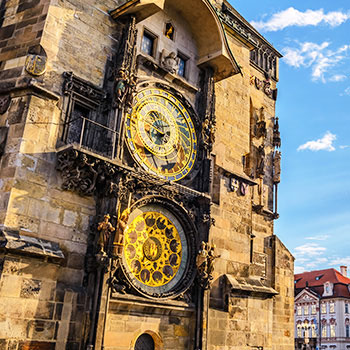HIS 104 World History II
International Relations & Political Science Program
Prague, Czech Republic
Dates: 8/28/18 - 12/15/18

HIS 104 World History II
OVERVIEW
CEA CAPA Partner Institution: Anglo-American University
Location: Prague, Czech Republic
Primary Subject Area: History
Instruction in: English
Transcript Source: TBD
Course Details: Level 100
Recommended Semester Credits: 3
Contact Hours: 42
DESCRIPTION
This course is primarily an overview of World History from approximately 1500 to 2000. The first few weeks focus on the pre-industrial world, including the Age of Exploration, the Islamic Empires, Early Modern China and Japan, and the development of the early American colonies and the Atlantic Slave Trade. A key turning point in the class is the Industrial Revolution (week 5), which drew a sharp line between industrial and pre-industrial regions, which often (but not always) corresponded to "western" and "non-western." The remainder of the course looks at how individuals in pre-industrial societies quickly adapted to the new, often brutal, but sometimes liberating situation. This will include topics such as the two world wars, the international appeal of the "communist" model, and the vexing problems of decolonization.
Modern World History is a vast subject, so instead of discussing every detail, the course emphasizes selected themes of universal significance. One of the aims of this course is to restore balance to educational systems that have traditionally emphasized the history of "western civilization" and largely ignored other regions. However, "the west" is also part of the world, and in the modern era it has been especially influential (through imperialism, for example).
At the time of Christopher Columbus, it is possible to argue that the great world civilizations were roughly "equal" in economic, intellectual, and political sophistication. So where did notions of "western superiority" (often expressed in terms of "race") come from? What made the rapid subjugation of pre-industrial peoples possible in the nineteenth-century? How did people around the world respond to this rapid political, economic, and cultural subjugation?
Although there was plenty of antagonism in modern World History, this course emphasizes cultural negotiation, continual change and adaptation, syncretism, and advantageous borrowing. Rather than presuming a simple "oppression" and "victimization" scheme (although there were a lot of victims!), this course looks at how rapidly and skillfully people around the world learned the technologies, languages, and ideologies of a new age, despite horrific and unfair conditions. "Race" proved no barrier to the creation of a modern, global, industrial culture.
Instead of "exotic" differences (which there sometimes were), this course emphasizes unifying similarities and shared global cultures. It emphasizes, for example, shared beliefs about religion and magic, the global culture of the Industrial Revolution, the nearly universal appeal of nationalism, the various versions of "communism" and its world-wide appeal, and finally, the global appeal of racial ideology.
Modern World History is a vast subject, so instead of discussing every detail, the course emphasizes selected themes of universal significance. One of the aims of this course is to restore balance to educational systems that have traditionally emphasized the history of "western civilization" and largely ignored other regions. However, "the west" is also part of the world, and in the modern era it has been especially influential (through imperialism, for example).
At the time of Christopher Columbus, it is possible to argue that the great world civilizations were roughly "equal" in economic, intellectual, and political sophistication. So where did notions of "western superiority" (often expressed in terms of "race") come from? What made the rapid subjugation of pre-industrial peoples possible in the nineteenth-century? How did people around the world respond to this rapid political, economic, and cultural subjugation?
Although there was plenty of antagonism in modern World History, this course emphasizes cultural negotiation, continual change and adaptation, syncretism, and advantageous borrowing. Rather than presuming a simple "oppression" and "victimization" scheme (although there were a lot of victims!), this course looks at how rapidly and skillfully people around the world learned the technologies, languages, and ideologies of a new age, despite horrific and unfair conditions. "Race" proved no barrier to the creation of a modern, global, industrial culture.
Instead of "exotic" differences (which there sometimes were), this course emphasizes unifying similarities and shared global cultures. It emphasizes, for example, shared beliefs about religion and magic, the global culture of the Industrial Revolution, the nearly universal appeal of nationalism, the various versions of "communism" and its world-wide appeal, and finally, the global appeal of racial ideology.








